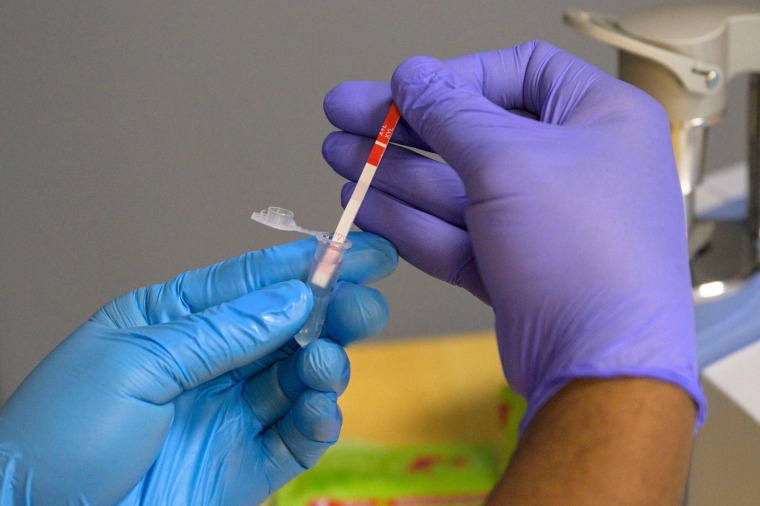The number of drug overdose deaths involving a powerful animal tranquilizer called xylazine has skyrocketed in recent years, the Centers for Disease Control and Prevention reported Thursday.
From January 2019 through June 2022, the percentage of fatal opioid overdoses in which xylazine was detected rose by 276%, from 2.9% to 10.9%, the CDC found.
Xylazine, also known as “tranq,” is an animal sedative not meant for human consumption. It can lull people into a state of unconsciousness for hours, increasing their risk for robbery or assault. It can slow the heart rate and lower blood pressure.

With chronic use, tranq causes dramatic, disfiguring wounds, usually on a person’s legs or arms. It’s not clear why this happens, and it can occur regardless of whether the drug was snorted, smoked or injected, said Dr. Jeanmarie Perrone, director of the Division of Medical Toxicology and Addiction Medicine Initiatives at the Perelman School of Medicine at the University of Pennsylvania.
Tranq is increasingly found laced in the illegal supply of fentanyl, a potent synthetic opioid primarily blamed for 70,601 overdose deaths in 2021, according to the National Institute on Drug Abuse. In March, the U.S. Drug Enforcement Administration warned about a growing threat from the drug combination, often called “tranq dope,” saying that the DEA had seized xylazine and fentanyl mixtures in 48 of 50 states.
The new findings come as drug deaths continue to rise dramatically. A 2022 CDC study revealed that the U.S. had experienced a 30% increase in deadly drug overdoses from 2019 to 2020 — the largest such increase ever recorded.
Most of those deaths were attributed to illicit fentanyl.
Despite the increased detection of xylazine in overdoses, there is no evidence that tranq increases the risk of death, although the mixture of xylazine and fentanyl can lead to worsening withdrawal symptoms.
The CDC analysis, based on data from the agency’s State Unintentional Drug Overdose Reporting System, found that 62% of people who’d used fentanyl on its own had no pulse when first responders arrived on the scene, compared with 53% who’d used fentanyl laced with xylazine.
“Xylazine doesn’t cause as much suppression of breathing as fentanyl does,” said Perrone, who was not involved with the new research.
That doesn’t mean tranq is safe.
“While it might not cause as many fatalities, we’re still really worried about the growing xylazine presence in the drug supply,” Perrone said.
Tranq wounds are extremely difficult to treat.
“There is a lot of tissue loss,” Perrone said. “There is a crater where their skin used to be, and it’s easily infected.” Infections can move into the bone or the bloodstream. Amputations are sometimes necessary.
Harm reduction specialists with the Boston Health Care for the Homeless Program say patients come to their facility daily for wound care. An increasing number of those wounds are related to xylazine, said Tehya Johnson, a nurse practitioner.
Johnson and her colleagues must often remove dead tissue from the wounds with special cleaning agents “to get them as healthy as possible and to promote healing,” which can take weeks or longer to clear up.
Does Narcan work on tranq overdoses?
Naloxone, an emergency lifesaving medicine used to reverse opioid overdoses quickly, is ineffective against xylazine because it is not an opioid.
Experts stress that naloxone, also known by the brand name Narcan, should always be given in case of any kind of overdose — regardless of whether tranq is also used — because naloxone is extremely effective in reversing the effects of fentanyl.
“What we want naloxone to do is restore breathing, and it still works to restore breathing very effectively, even in the presence of xylazine,” Perrone said. “It may not wake the patient up because they may still be sleepy from their xylazine, but that is actually fine. We can get the patient to the hospital safely.”
In the new CDC study, naloxone was administered in fewer than a quarter of cases, regardless of whether xylazine was ultimately detected.
Fentanyl is more lethal
Connecticut, Maryland and Pennsylvania reported the highest numbers of fentanyl deaths in which xylazine was also found. That could reflect either regional differences in the illegal drug supply or increased monitoring for tranq in toxicology tests.
“We have to be better at testing the different substances that are out there,” said Dr. Michael Baca-Atlas, assistant professor of family medicine and psychiatry at the University of North Carolina School of Medicine in Chapel Hill. “It’s so important to understand what the community is using and what’s in the drug supply. It can change public health messaging very quickly.” Baca-Atlas was not involved with the CDC study.
Still, it’s not xylazine that scares experts the most.
“It’s 100% fentanyl,” Perrone said. “Fentanyl is the first and foremost emerging threat because of its incredible lethality and potency in stopping breathing.”
Follow NBC HEALTH on Twitter & Facebook.






